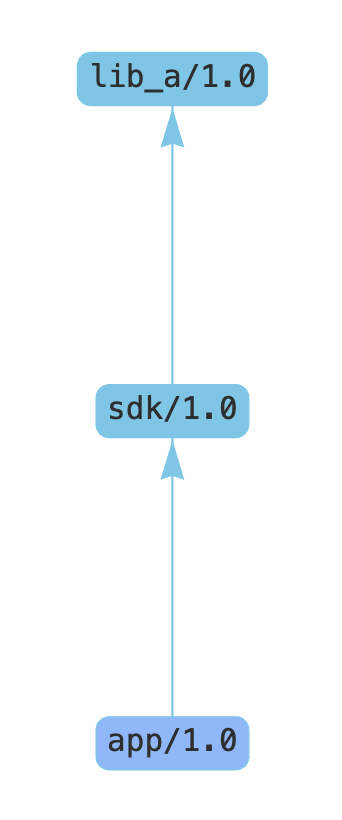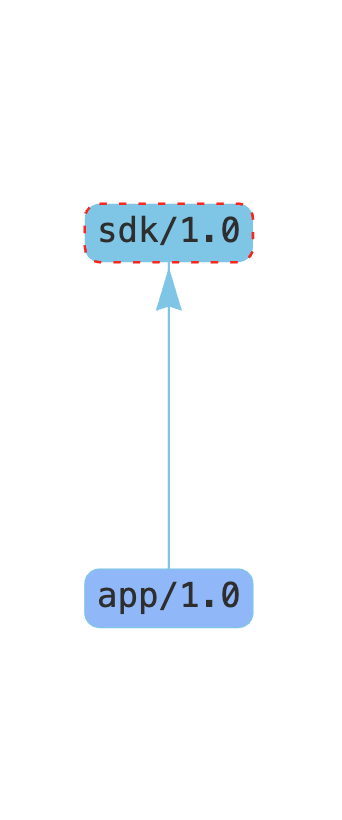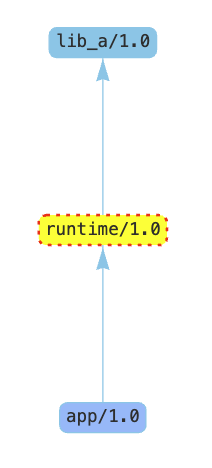Introducing vendoring packages: Create and share packages decoupled from their dependencies
We’re excited to roll out a highly anticipated feature that will significantly enhance how Conan users, including software vendors, manage and distribute their packages: the “vendor” feature. This new addition aims to streamline the deployment and sharing processes of Conan packages, offering greater control over internal recipes and binaries without exposing proprietary details, or simply isolating implementation details across organization teams. Let’s dive into what “vendor” packages bring to the table and how they can benefit your workflow.
What is a “vendoring package”?
The “vendor” feature allows developers to distribute their software through Conan while keeping internal dependencies and recipes private. By enabling the vendor attribute in your Conan recipe, you can prevent Conan from downloading the recipes and binaries of your package’s dependencies. This means you can encapsulate all necessary binaries, libraries and other artifacts within your package, ensuring that end-users have no access to your internal package recipes, build details or private repositories.
Key Benefits
-
Enhanced Privacy and Security
By using the vendor feature, you can share your software packages without exposing the recipes and binaries of your internal dependencies. This is crucial for maintaining the confidentiality of proprietary code and internal build processes.
-
Streamlined Distribution
- The vendor feature simplifies the distribution process. Whether you are using Conan Center Index or a private artifact repository, pre-built binaries for various configurations can be included, ensuring that end-users receive a ready-to-use package without the need for additional downloads
- Vendoring can also be useful inside organizations by allowing sharing of pre-compiled binaries that completely hide their dependencies, for security, simplicity or convenience reasons.
- SDKs between different work groups without sharing internals
-
Reduced Build Times
When a consumer installs a vendored recipe, Conan won’t download individual dependency binaries or recipes from the server, potentially saving significant time and storage space, especially in production environments.
Usage Example
For this example, ensure that you have at least Conan v2.4.1 installed.
1. Create a basic library from the CMake template
$ mkdir vendor-example && cd vendor-example
$ mkdir lib_a && cd lib_a
$ conan new cmake_lib -d name=lib_a -d version=1.0
$ conan create .
2. Create a package depending on the previous library, which will be the one we will use to vendor its dependencies
$ cd .. && mkdir sdk && cd sdk
$ conan new cmake_lib -d name=sdk -d version=1.0 -d requires="lib_a/1.0"
$ conan create .
3. Create a consumer application depending on the sdk library:
$ cd .. && mkdir app && cd app
$ conan new cmake_exe -d name=app -d version=1.0 -d requires="sdk/1.0"
4. Install the created application
$ conan install . --build=missing
======== Computing dependency graph ========
...
Requirements
lib_a/1.0#ab64452c42599a3dc0ee6a0dc90bbd90 - Cache
sdk/1.0#1cb781c232f63845b7943764d8a084ed - Cache
======== Computing necessary packages ========
Requirements
lib_a/1.0#ab64452c42599a3dc0ee6a0dc90bbd90:39f48664f195e0847f59889d8a4cdfc6bca84bf1#e34a89988cafb2bf67f6adf40b06f442 - Cache
sdk/1.0#1cb781c232f63845b7943764d8a084ed:12ffb661ea06cee312194b5f6acd48e8236b8ed8#9127cf762dfd1a1f505ecd1d3ac056b9 - Cache
Transitive dependencies are required as expected.
5. Generate the graph to see a later comparison
$ conan graph info . --format=html > graph.html
6. Now let’s dive into the vendoring feature. Some changes need to be made in the SDK conanfile.py:
- As this example aims to make a vendoring static library, we should first change the
package_typeaccordingly - Set the class attribute
vendortoTrue. This will enable the vendoring feature - Remove the unnecessary shared option from options and default_options, and remove configure method because it not needed anymore
- Actually repackage the lib_a library inside the SDK. As we are generating a static library, we can achieve this by copying the
liblib_a.astatic library inside the SDK library - Finally, update the
cpp_info.libsadding thelib_adependency for consumers
from conan import ConanFile
from conan.tools.cmake import CMakeToolchain, CMake, cmake_layout, CMakeDeps
from conan.tools.files import copy
import os
class sdkRecipe(ConanFile):
name = "sdk"
version = "1.0"
package_type = "static-library" # LINE CHANGE
vendor = True # LINE CHANGE
# Binary configuration
settings = "os", "compiler", "build_type", "arch"
options = {"fPIC": [True, False]} # LINE CHANGE
default_options = {"fPIC": True} # LINE CHANGE
# Sources are located in the same place as this recipe, copy them to the recipe
exports_sources = "CMakeLists.txt", "src/*", "include/*"
def config_options(self):
if self.settings.os == "Windows":
self.options.rm_safe("fPIC")
def layout(self):
cmake_layout(self)
def requirements(self):
self.requires("lib_a/1.0")
def generate(self):
deps = CMakeDeps(self)
deps.generate()
tc = CMakeToolchain(self)
tc.generate()
def build(self):
cmake = CMake(self)
cmake.configure()
cmake.build()
def package(self):
# Repackage static dependencies inside the package supporting different OS
# LINES CHANGE
copy(self, "*.a", src=self.dependencies["lib_a"].cpp_info.libdir, dst=os.path.join(self.package_folder, self.cpp_info.libdir))
copy(self, "*.lib", src=self.dependencies["lib_a"].cpp_info.libdir, dst=os.path.join(self.package_folder, self.cpp_info.libdir))
cmake = CMake(self)
cmake.install()
def package_info(self):
self.cpp_info.libs = ["sdk", "lib_a"] # LINES CHANGE
7. Apply the changes and create the SDK package:
$ cd ../sdk
$ conan create .
8. Finally, let’s reinstall the application again.
$ cd ../app
$ conan install . --build=missing
======== Computing dependency graph ========
Graph root
...
Requirements
sdk/1.0#f2fd2a793849725303073d37b15042b2 - Cache
======== Computing necessary packages ========
Requirements
sdk/1.0#f2fd2a793849725303073d37b15042b2:5d605f63db975c8c6004cc0a0b5c99c99dce6cc3#92c538ec767c2ff02a2fddf6b4106d02 - Cache
As it can be seen, while computing the dependency graph, conan does not
retrieve either the recipe of lib_a/1.0 nor the binaries.
9. We could try to even remove lib_a from our local cache and install again the application:
$ conan remove "lib_a*" -c
Found 1 pkg/version recipes matching lib_a* in local cache
Remove summary:
Local Cache
lib_a/1.0#ab64452c42599a3dc0ee6a0dc90bbd90: Removed recipe and all binaries
$ conan install .
...
Requirements
sdk/1.0#f2fd2a793849725303073d37b15042b2 - Cache
...
Install finished successfully
It works!!! Here is where vendoring feature shines. Package creators can distribute their packages without needing to distribute their private dependencies.
10. Generate graph info of the application using vendored SDK
$ conan graph info . --format=html > vendored-graph.html
Comparison between graphs:
 Standard sdk graph
Standard sdk graph
 Vendored sdk graph
Vendored sdk graph
Note: Red dashed borders mean the package is vendoring its dependencies
How should the “vendor” feature be used?
For releasing a vendored package, the creator should follow these steps:
-
Encapsulation of dependencies
Ensure that all dependencies are correctly repackaged inside the vendoring package. This involves encapsulating binaries, static libraries, and shared libraries within the vendoring domain. Users may use the vendoring package with different kinds of environments, dependencies, shared libraries enabled, etc. The package creator is responsible for ensuring no conflicts should surface.
-
Distribution of vendoring packages
When distributing a vendoring package, pre-built binaries should be generated for the different configurations your consumers might need. That way, users could use the vendored package without needing to compile it from scratch and without the need to have direct access to the package dependencies (which may be private for the organization)
Advanced details
To understand the inner workings of the “vendor” feature, it is essential to grasp the concept of a dependency graph in Conan. When Conan builds the dependency graph for a package, it downloads the recipes and binaries for all dependencies, constructing a detailed map of all relationships and configurations involved.
The dependency graph is a critical component in Conan, representing how packages depend on each other. It ensures that all necessary binaries and libraries are correctly resolved and compatible. Typically, Conan expands this graph fully, downloading all the recipes and binaries involved. However, with the vendor feature enabled, you can limit this expansion.
Limiting Graph Expansion
By enabling the vendor option, the consumer of the recipe is instructed not to expand the dependency graph beyond the vendored package. This means Conan won’t download the recipes or binaries of internal dependencies, keeping the build process lean and secure. This feature is particularly useful for:
- Encapsulation: Keeping private dependencies hidden and secure.
- Efficiency: Reducing download and build times by not fetching unnecessary components.
- Control: Allowing software vendors to manage how their packages are used and distributed without exposing internal details.
Forcing the build of a vendoring package
We have seen how a vendor can be used from a consumer directly downloading binaries without needing to download any dependency data.
But what happens if we want to compile the internal vendored dependencies?
1. As we have previously deleted lib_a package, we should re create it:
$ cd ../lib_a && conan create .
Now, let’s force the build of our previous SDK example:
$ cd ../app
$ conan install . --build="sdk/1.0"
...
======== Computing necessary packages ========
sdk/1.0: Forced build from source
Requirements
sdk/1.0#f2fd2a793849725303073d37b15042b2:5d605f63db975c8c6004cc0a0b5c99c99dce6cc3 - Invalid
ERROR: There are invalid packages:
sdk/1.0: Invalid: The package 'sdk/1.0' is a vendoring one, needs to be built from source, but it didn't enable 'tools.graph:vendor=build' to compute its dependencies
Trying to build a vendor package will fail by default unless setting the tools.graph:vendor configuration to “build”.
2. Once the vendor configuration is enabled, the user must have access to packaged dependencies as if it were a normal package.
$ conan install . --build="sdk/1.0" -c tools.graph:vendor=build
...
======== Computing necessary packages ========
sdk/1.0: Forced build from source
Requirements
lib_a/1.0#ab64452c42599a3dc0ee6a0dc90bbd90:39f48664f195e0847f59889d8a4cdfc6bca84bf1#5a8bfa1c980c2008e7e24996a4b48477 - Cache
sdk/1.0#f2fd2a793849725303073d37b15042b2:5d605f63db975c8c6004cc0a0b5c99c99dce6cc3 - Build
======== Installing packages ========
lib_a/1.0: Already installed! (1 of 2)
...
Install finished successfully
When forcing the compilation of a vendored dependency, the graph expands again, revealing the encapsulated dependencies necessary for the build.
3. Let’s generate the graph again to see how the expansion works:
$ conan graph info . --build="sdk/1.0" -c tools.graph:vendor=build --format=html > vendored-expanded-graph.html
 Vendored expanded graph
Vendored expanded graph
Note: Red dashed borders means the package is a vendor and yellow background means the package has been forced to be built
4. To verify that a vendored package does not need to have their transitive
dependencies accessible unless forced to build, we can try to remove our lib_a package from our local cache and install again:
$ conan remove "lib_a*" -c
Found 1 pkg/version recipes matching lib_a* in local cache
Remove summary:
Local Cache
lib_a/1.0#ab64452c42599a3dc0ee6a0dc90bbd90: Removed recipe and all binaries
$ conan install . --build="sdk/1.0" -c tools.graph:vendor=build
...
======== Computing dependency graph ========
lib_a/1.0: Not found in local cache, looking in remotes...
lib_a/1.0: Checking remote: conancenter
...
Requirements
sdk/1.0#f2fd2a793849725303073d37b15042b2 - Cache
ERROR: Package 'lib_a/1.0' not resolved: Unable to find 'lib_a/1.0' in remotes.
As expected, an “Error: Package ‘lib_a/1.0’ not resolved” is raised when forcing the build of the vendored package if we do not have access to its dependencies.
Proxy vendor for Extra Privacy
For vendors that want to further obscure their dependency names and versions, a proxy vendored package can be created. This proxy package should include all internal/private dependencies and should be made inaccessible to clients.
The primary vendored recipe depends on this proxy package, and by marking both packages as vendored, the actual dependencies and their versions will be hidden from the end-user.
Impact on Package ID Calculation
To support the vendor feature, we’ve adjusted how the package_id is calculated
for vendored packages. Since dependencies and their versions are invisible to
the end-user, they are excluded from the package_id calculation. Only the
recipe revision will change with recipe content changes, but the package_id
will remain the same. This ensures that any kind of change to internal
dependencies (updating, adding or removing) will not alter the package_id,
saving time and effort in environments where consistent package IDs are
crucial.
It goes without saying that the provider of packaging the package should be in charge of updating the version of the package when any of its internal dependencies change version in order let consumers know that the package has changed in some way.
Conclusion
The “vendoring” feature is a powerful tool for any organization looking to distribute software through Conan while maintaining control over internal dependencies. By encapsulating and securing your binaries, you can ensure a smooth and efficient distribution process, enhanced privacy, and significant time savings. We’re thrilled to bring this feature to the community and look forward to seeing how it enhances your workflows.
On the other side, we recommend avoiding abuse of this new feature, for
example, we do not consider that it has any place in conan-center-index or in
other remotes, except perhaps for some application type package (tool
requires).
Stay tuned for more updates and, as always, happy packaging with Conan!



